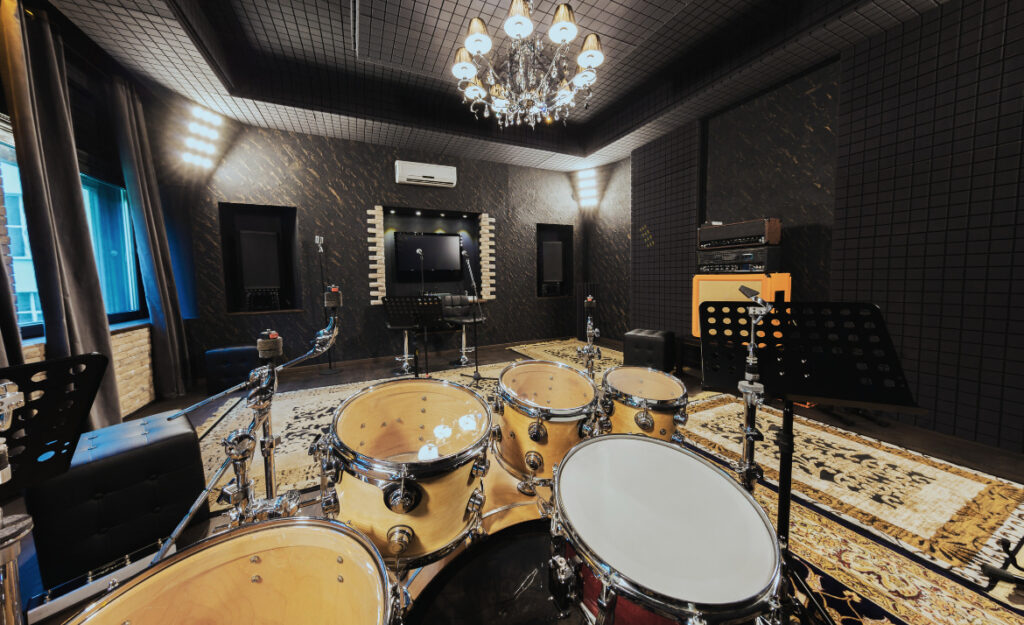Thick drum sounds can fall flat in a harsh or echo-filled room, but dialing in room acoustics adjustments unlocks crisp, musical results. Drummers chasing the perfect groove want every kick and snare to sound intentional—not lost in a wash of noise.
Balancing your room lets every drum voice speak clearly. Achieving this isn’t reserved for pro studios; realistic tweaks make big differences, even in home spaces. Simple, tested acoustic techniques help shape both tone and feel.
If you’ve struggled with muddy toms or piercing cymbals, you can take control. Explore these science-backed strategies to transform your drum room or stage for a more musical, comfortable drumming experience.

Tailoring Wall Treatments for Focused Drumming Sessions
Positioning the right materials on your walls changes the sound of your kit from boomy to balanced. Strategic room acoustics adjustments help lock in attack, punch, and clarity so each practice or recording session feels focused.
Musicians often react with surprise when a single change—like adding thick curtains or absorption panels—lets them finally hear ghost notes and subtle brushwork. The right approach invites detail, not chaos.
Absorption Panel Placement for Tight Drum Tone
Mount thick absorption panels at head height behind and to the sides of your kit. This focus absorbs early drum reflections, which would otherwise bounce and muddy your drum hits’ clarity in the room.
Use enough coverage to target the main sound sources, but don’t blanket every wall. Leaving some reflective surfaces keeps the room lively, allowing natural resonance to complement your dynamics.
Imagine panels as a “sonic window”—block enough light (sound) to prevent glare, but let enough through for vibrancy. Start with corners and key reflection points, then listen and adjust coverage until snare and toms sit where you want them.
Diffusers for Preserving Liveliness Without Harshness
Install wooden or foam diffusers on walls opposite your kit. These scatter sharp high frequencies, so cymbals and high drums stay energetic without ear-fatiguing reflections.
Diffusers can be store-bought or DIY. Place them at ear height, or behind overhead microphones, to prevent metallic “pinging.” If your room feels lifeless, diffusers restore punch and space without muddying the mix.
Try moving your stool a few feet at a time, clapping or snapping to test. Diffusers distribute energy like textured wallpaper for sound—spreading it smoothly. If snare hits sound harsh, adjust placement until you hear depth and warmth.
| Material | Function | Placement Tips | Action Step |
|---|---|---|---|
| Fiberglass panel | Absorbs mids/highs | Side and rear walls | Install 3-6 panels per 100 sq ft |
| Curtains | Reduce flutter echo | Over windows and doors | Hang thick, floor-length drapes |
| Wooden diffuser | Scatter high frequencies | Rear wall or ceiling | Use 1-2 per reflective wall |
| Bass trap | Control low-end buildup | Corners and behind kit | Stack in pairs for best results |
| Foam tile | Minimizes sharp highs | Above cymbals, near mics | Test location with handclaps |
Floor Surfaces That Reinforce or Tame Drum Resonance
Choosing what’s underfoot becomes part of your signature sound. Floors shape how low-end and stick attack interact—a surprising factor in room acoustics adjustments that most drummers overlook.
Hardwood floors let kicks and toms breathe, but too much reflection brings muddiness. Carpet derails excess ring but can swallow subtlety. Matching your groove to the right floor material keeps your playing consistent and expressive.

Drum Recording Techniques: Home Studio Essentials
Get step-by-step tips on drum tuning, mic placement, editing, and mixing for pro results with any gear.Layering Rugs for Measured Damping
Lay down a heavy rug under your kit to absorb both stray vibration and harsh slapback. It visually anchors your drum position and ensures that nuanced brushwork isn’t overwhelmed by resonance.
- Use thick, densely woven area rugs for maximum sound control—avoid thin mats that don’t block low-end boom.
- Check the rug covers the entire footprint of your kit, including hardware; this keeps pedal noise and reflections at bay.
- If your rug slides, add a rubberized underlayer for safety as well as further vibration dampening.
- Try rug layering—two smaller carpets can target the kick area and cymbal stands for precision control.
- For portable setups, roll up your preferred rug for use at gigs and jam sessions to keep your sound consistent.
This approach lets you dial in attack without sacrificing the “air” of a good room. Experiment with rug thickness and placement; if your snare sounds choked, try a lighter carpet or reveal more floor.
Utilizing Drum Mats for Consistency Between Spaces
Place a purpose-made drum mat under your kit when moving between practice rooms, friends’ houses, or different live venues. Familiar ground makes your sound familiar, too.
- Choose drum mats with non-slip bottoms to avoid creeping during energetic fills, which also helps keep memory muscle sharp by locking your kit in the same spot every time.
- Look for mats with marked or textured positions for each drum or cymbal stand; this takes the guesswork out of fast setups.
- If you travel, select a mat that rolls compactly for transport but stays flat on unfamiliar stages—trust your set won’t wander mid-song.
- Select darker colors to hide stick marks and scuffs, helping your performance space look clean and presentable whenever guests or clients visit.
- Some drummers add a layer of foam beneath their mat for extra resonance control—good for taming boomy floors in old studios or wooden stages.
Armed with a portable mat, you can walk into any space and recreate your dialed-in acoustic sweet spot within minutes. Consistency leads to relaxed playing and faster progress.
Ceiling and Corner Adjustments That Make or Break Your Room
Ceilings and corners magnify or squash drum energy, affecting how well your rhythms project. Addressing these areas with targeted room acoustics adjustments improves punch and reduces muddle.
Bass Trap Installation for Defined Low-End Punch
Position bass traps in each corner where walls meet the floor and ceiling. These dense, wedge-shaped panels capture runaway low frequencies and stop your kick drum from blooming uncontrollably.
Heavier drums—such as 22″ kicks and deep floor toms—gain clear separation and tighter punch when corner zones absorb excess energy. This clarity cuts through both live and recorded mixes, especially at higher volumes.
Install traps vertically for full-height coverage. If you only treat the bottom three feet, energy will still pool above your head—go all the way up for a balanced response.
Cloud Panels Above the Drum Kit for Balanced Reflections
Hang absorption clouds (broad, thick panels) from the ceiling, directly above your kit. Mounted 2–4 inches down, they grab harsh vertical reflections and create a spacious, yet controlled drum soundscape.
Use clouds in rooms with hard, low ceilings or lots of glass—this prevents the fast, metallic slapback that can flatten snare and cymbal textures.
Clouds shouldn’t cover the whole ceiling. Target the area above your kit and mic stands; if high toms sound diffuse, nudge the clouds outward until the sound tightens up.
Furniture, Gear, and Room Arrangement to Support Great Drum Sound
How you place your drums and surrounding gear transforms both your playing comfort and the sound quality others hear. Smart room acoustics adjustments work hand-in-hand with positioning choices.
Every move you make inside your drum room or live setup changes where energy bounces, dies, or enhances your playing style—treat your layout as part of your instrument.
Optimizing Drum Placement for Balanced Reflection
Position your drum kit so that it’s not centered along any wall, and avoid equal distances from all sides. Symmetry causes energy to pool and stand waves to form, hurting low-end clarity.
Angle your kit slightly toward absorbent surfaces or bookcases, which both diffuses sound and breaks up harsh echoes. If there’s a window, move the kit so cymbal reflections hit curtains instead of glass.
Replay a simple kick-snare pattern while moving your stool, stand, or ride cymbal location. Listen for areas where drums ring clearer and less boomy, then mark that “sweet spot” for consistent setups.
Seating, Stands, and Accessories for Room Adaptation
Choose a heavy, height-adjustable drum throne with extra padding. Stable seating reduces accidental squeaks and allows you to focus on the music, not balance.
Aim for lightweight, portable stands that don’t vibrate or flex during loud passages. Avoid placing extras (like unused floor toms) where they can sympathetically vibrate—move or mute them between songs or takes.
If you use electronic drum pads, ensure cabling is clipped up and away from other hardware to cut down on rattle and stray noises leaking into mics. Every item counts toward a holistically quiet, controlled space.
Room Size and Shape: Working With What You Have
The size and natural proportions of your practice or gig space set the boundaries for your sound. Smart room acoustics adjustments make even small or odd-shaped rooms feel comfortable and clear.
Irregular rooms disrupt predictable standing waves, while perfect squares or rectangles encourage resonance and flutter echoes, which mask subtle stickwork. Treat dimensions as starting points instead of obstacles.
Adapting Rectangular Rooms for Clean Drum Audio
Offset your drum kit along the long wall, never dead center. This produces uneven reflection paths and breaks up long bass waves, helping toms snap back with clarity instead of rumbling uncontrolled.
Angle freestanding bookshelves or gear racks in corners to act as impromptu diffusers, scattering high-end energy while preserving room character. Move items and listen for changes in how the snare decays.
If you can’t treat every wall, focus on parallel surfaces across from each other; softening these with foam or curtains targets flutter echo, letting delicate stick checks shine through.
Leveraging Odd-Shaped Spaces and Alcoves
Take advantage of L-shaped or attic rooms by tucking your drum kit into nooks with high ceilings. Use thick rugs or foam where angled ceilings meet walls to catch stray highs and lows.
Stack boxes or small furniture in unused alcoves. This creates pockets of “dead space” where unwanted resonance gets trapped, keeping the rest of the room focused.
Listen from both the drum stool and a friend’s position to hear blind spots—treat uneven corners first, then reassess your drum’s attack and sustain after each tweak.
Adaptive Acoustic Tactics for Different Drumming Scenarios
Different playing situations require different room acoustics adjustments. Whether you’re preparing for jazz practice, a rock rehearsal, or a live mic’d performance, adapt your environment for each need.
Being flexible with your setup ensures your kit responds dynamically, preserving articulation and energy regardless of the musical setting or listener expectations.

Quick Changes for Rehearsals Versus Recordings
Before rehearsal, prioritize blocking strong reflections—hang extra blankets, shift rugs around, or close curtains to dry up the space and illuminate mistakes or timing artifacts.
For recording, fine-tune placement of absorption panels and adjust mic distance to capture the direct kit sound without excessive room, letting engineers or software add “air” later as desired.
If you’re running both rehearsal and tracking in the same day, keep a set of removable panels handy to swap the vibe in minutes. Use a simple script: “Panels on for warm-up, off for takes.”
Drummer’s Checklist: Live Gig Quick Setup
- Scout the stage for reflective surfaces near your kit before setting up; use available carpets or sound blankets to shield problem spots.
- Place your monitor or amp close, angled up at ear level; avoid aiming at glass, as this multiplies harshness and mud.
- If the venue sounds boomy, put a jacket or towel in the kick drum for immediate bass control and a focused thump.
- Use cloth gaff tape for quick cymbal dampening—tape a tab under the crash edge to knock down ring during intros or solos.
- Ask sound techs where overhead mics point—adjust cymbal stands so the brightest cymbals aren’t aimed straight at the nearest reflective back wall.
Each step transforms venue chaos into a more balanced setting, letting you focus on groove, not guessing about sound bounce mid-show.
Final Thoughts on Shaping Your Ideal Drum Room
Every drummer’s space can improve with smart room acoustics adjustments, no matter its size or shape. Listening closely and customizing treatments unlocks a signature sound you’ll love playing, and others will love hearing.
The tools and techniques discussed here empower drummers to hear the true voice of their kit. Attentive setup shapes both personal enjoyment and professional results, yielding practice and performances that stand out.
Continually fine-tune your space, take creative risks, and experiment freely. Careful attention to acoustics ensures every session is as musical, focused, and inspiring as you imagine.



